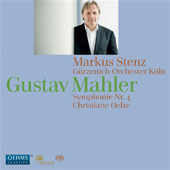
DEFINITIVE RECORDINGS

My esteemed colleague and review collaborator, Stephen Habington, previously noted in his review of the Gustav Mahler Symphony No. 5 under the
direction of Markus Stenz, that it was the best version to come along in many years, and that this new Oehms Classics cycle was
well worth anticipating. I must agree that after hearing this new recording of the Symphony No. 4 in G major, that his observations and intuition are
accurate and a good omen of things to come.
The first movement Bedächtig, nicht eilen (sedate or prudent, not rushed) is taken at a relaxed pace, slower than most, and is very appropriate considering
the tempo indications. This is the movement depicting the heaven on earth that is nature untouched by man. Its myriad number of creatures depicted by various instruments.
This recording captures this so well, as if each instrument is a different color and Stenz, using his baton like a paint brush, is simply painting a picture of life, from flowering
meadows to birds, fish and even frogs. Take for example the middle section, where Pan plays a wonderful melody on the flute, calling on all living things to answer his
call and follow him on life's adventure. They all join in the march until they encounter man (that foreboding bugle call that opens the Fifth symphony) and recoil
out of fear. Very well captured in this interpretation. And the wonderful way Stenz holds everything back in the final minute before hitting those two final majestic chords
is unusual, yes, but quite the revelation.
The pace of the second movement is also very well judged, and the grotesque fiddling of the children's concept of the Grim Reaper sets the tone perfectly for the whole
segment. The disjointed dance rhythms are well accented and marked, and again each and every instrument is distinctly clear and precise.
The third movement Ruhevoll, poco adagio (peacefully, slow), one of Mahler's most inspired slow movements, is surprisingly a fraction faster here than in
some other noteworthy interpretations, but again Stenz, based on the rest of the work, makes this work to his advantage by giving the music an innocent cheerfulness
rather than a dreamy repose. The sudden and glorious glow of heaven's light near the end is floor-shaking in its power, and the sublime moments that follow, with their
quiet echoes of the "Resurrection" Symphony, are just perfect.
The final movement Sehr behaglich (Das himmlische Leben), (very content, the heavenly life), based on a Wunderhorn poem about the beatitudes of
infinite varieties of food in heaven, is well captured. This is the movement where the soprano Christiane Oelze steps in and sings about apples, bread,
lamb, hares and so on, until contentment is attained and blissful sleep can follow. Now, at certain moments, especially in the higher register and when the music is moving
at a brisk pace, her voice displays a bit of a harshness, but, and I do mean BUT, near the end, when the mood shifts, when the tempo relaxes into that wonderful cradle
like rocking, when the violas take over the melody, when the notes descend into a lower register, her voice becomes a thing of beauty. And just wait until you hear how
she delivers that long descending glissando at the 6:38 mark. Unbelievable. I've never heard anyone do it that way before. Just that is worth the price of
admission.
Again, the Oehms Classics engineers have delivered a pristine recording that gives full justice to Mahler's sound world, and then some. There are many
fine recordings on the market of this wonderful symphony, but many of them are like carbon copies of each other. This one takes a fresh look at the score, and succeeds
in re-creating the essence of the work and reproducing Mahler's vision.
Jean-Yves Duperron - July 2010